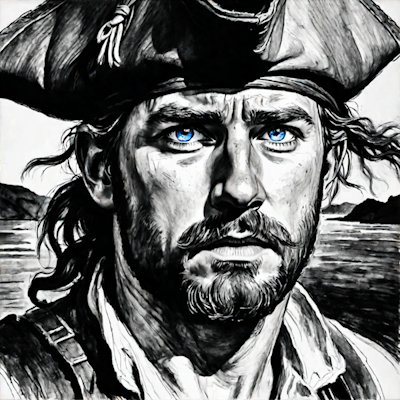
Pirate captains were unlike captains on merchant and naval ships and even on some privateer vessels, who, usually coming from the privileged class, had absolute authority on their ships and could act like tyrants without repercussion. The amount of authority a pirate captain had could vary from vessel to vessel. Pirates weren’t generally willing to accept too much authority and it would have been difficult to lead a group of individuals who valued their liberty above all else through coercion, although the crew generally accepted they needed a some sort of representative or figurehead. Many mariners had turned to piracy precisely because of the strict discipline and harsh punishments of life on merchant and naval ships.
 Pirate Captains were usually elected because they were respected, not feared. They had to possess ability, courage, and charisma, and be willing to lead from the front. They also needed capture enough prizes to keep the crew happy and fed. A pirate captain would often be called a commodore if he commanded a flotilla of ships, and in 17th century some buccaneer captains preferred the title of admiral. Sometimes captains were owners of the ship like Stede Bonnet and Charles Swan, but usually they were elected on the basis of their skills and abilities. When a captain was chosen it is unknown whether the crew voted or openly, or by secret ballot, but due the danger of peer pressure the latter might have been true. There are no recorded cases of pirates duelling to decide who would become captain. A captain could be democratically deposed like Charles Vane was in 1718, for failing to attack a ship as his crew had wished, being replaced by Jack Rackham. An unpopular pirate captain could even be marooned as in the case of Edward England, who was abandoned in Mauritius in 1720 with three members of his crew. There was a tendency after losing their last base in the Caribbean 1718 for pirate captains to become more tyrannical, such as in the case of Bartholemew Roberts, although Captain Kidd is said to have run his vessel autocratically from 1696-99.
Pirate Captains were usually elected because they were respected, not feared. They had to possess ability, courage, and charisma, and be willing to lead from the front. They also needed capture enough prizes to keep the crew happy and fed. A pirate captain would often be called a commodore if he commanded a flotilla of ships, and in 17th century some buccaneer captains preferred the title of admiral. Sometimes captains were owners of the ship like Stede Bonnet and Charles Swan, but usually they were elected on the basis of their skills and abilities. When a captain was chosen it is unknown whether the crew voted or openly, or by secret ballot, but due the danger of peer pressure the latter might have been true. There are no recorded cases of pirates duelling to decide who would become captain. A captain could be democratically deposed like Charles Vane was in 1718, for failing to attack a ship as his crew had wished, being replaced by Jack Rackham. An unpopular pirate captain could even be marooned as in the case of Edward England, who was abandoned in Mauritius in 1720 with three members of his crew. There was a tendency after losing their last base in the Caribbean 1718 for pirate captains to become more tyrannical, such as in the case of Bartholemew Roberts, although Captain Kidd is said to have run his vessel autocratically from 1696-99.
The captain’s responsibilities included making important decisions, representing the crew when dealing with outsiders, such as in trade or during a parley, as well as supervising the general running of the ship, keeping accounts and a journal, and deciding when and where to repair ship when. They also oversaw the conduct of the crew, intervening in disputes; they needed to be able to raise morale; they could mediate between various religious and ethnic groupings; they could dish out punishments, and decided when to attack another vessel. In most cases the crew gave their input and voted to support the captain’s decision or overturn it – the captain himself often had two votes. The pirate captain only ever had absolute authority in battle. A quartermaster was also elected as a counterbalance to the captain.
 The pirate captain usually shared the same life of the crew, sometimes being given his own cabin and a few extra luxuries, although in many cases the crew could enter the cabin as they pleased. They usually received two shares of the plunder, sometimes more. Some pirates such as Blackbeard and Bartholemew Roberts dressed the part of a captain, others dressed no differently than the crew when on board the ship. While many pirates faced a real risk of being hanged, the pirate captains were almost guaranteed such a fate.
The pirate captain usually shared the same life of the crew, sometimes being given his own cabin and a few extra luxuries, although in many cases the crew could enter the cabin as they pleased. They usually received two shares of the plunder, sometimes more. Some pirates such as Blackbeard and Bartholemew Roberts dressed the part of a captain, others dressed no differently than the crew when on board the ship. While many pirates faced a real risk of being hanged, the pirate captains were almost guaranteed such a fate.
Read about some of the most successful pirate captains in the article Most Successful Pirate and buccaneer Captains on The Way of the Pirates website. For more information on pirate captains watch the following video.
